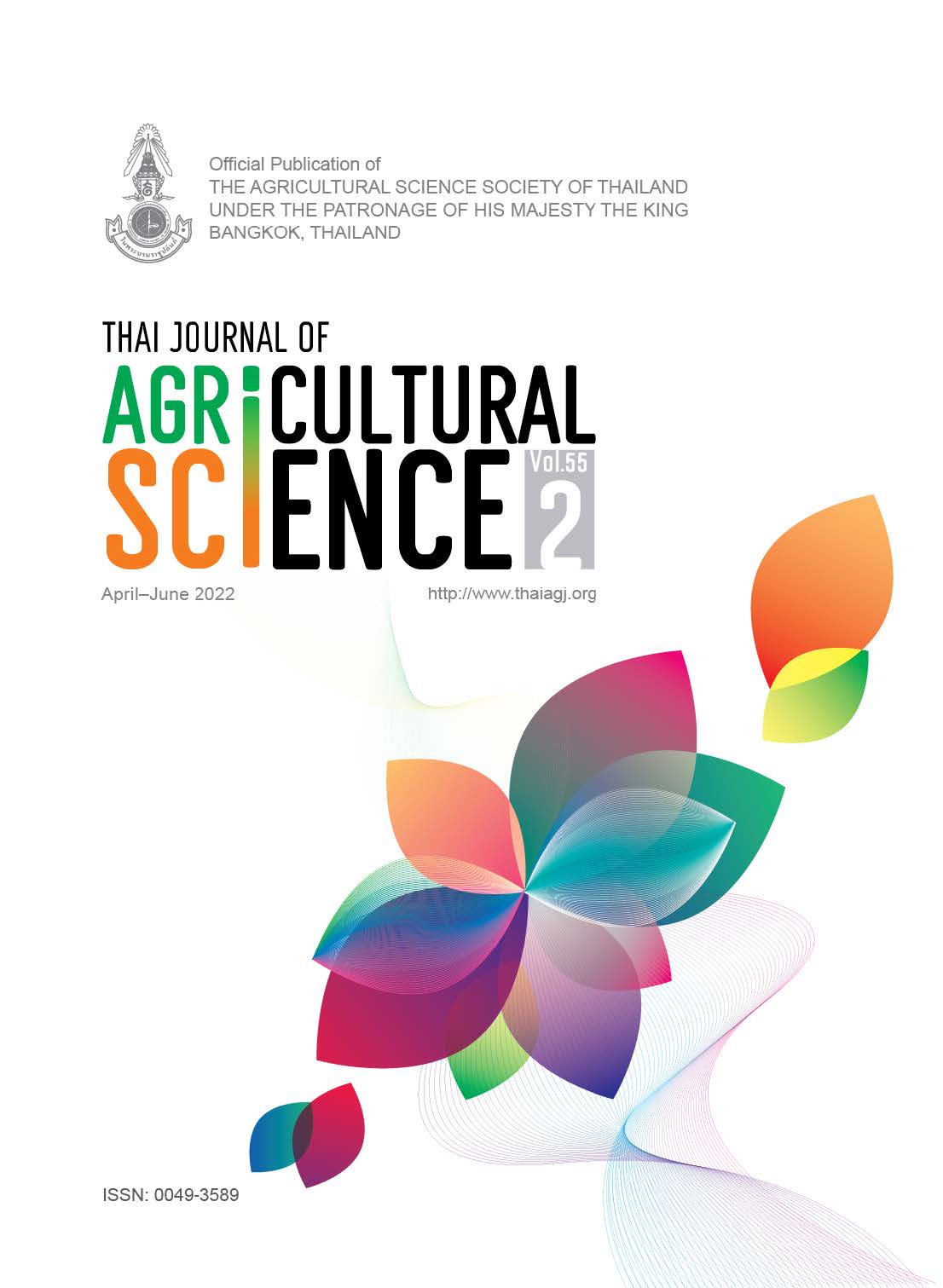Correlation and path-coefficient analyses of yield and vegetative traits of tall coconut accessions
Main Article Content
Abstract
As a result of the prolonged gestation period of coconut, there is need to make selection for coconut improvement with the vegetative traits at pre-flowering stage. Therefore, the objective of this study was to evaluate the contributions of vegetative traits to components of yield in coconut. Coconut palm accessions of the tall type collected from South West (SW; n = 22), South East (SE; n = 17), North Central I (NCI; n = 20) and North Central II (NCII; n = 19) were evaluated over two years. The fruit and vegetative traits were evaluated using ANOVA, correlation and the path coefficient analyses. ANOVA indicated that there was significant difference for all traits evaluated at the locations. The coefficient of variation expatiated that the level of variability was lower in the vegetative traits (6.29–12.40%) than the fruit traits (30.73–54.99%). There was high positive significant correlation between the fruit weight per hectare and the other fruit yield components evaluated; husk weight (0.74; P < 0.01), nut weight (0.88; P < 0.01), split nut weight (0.86; P < 0.01), water volume (0.77; P < 0.01), fresh meat weight (0.82; P < 0.01) and copra weight (0.76; P < 0.01). Thus, selection for high fruit weight will accelerate improvement for other components of yield. There was significant positive correlation between fruit weight and each of number of fronds (0.27; P < 0.05), crown diameter (0.24; P < 0.05) and leaf spread (0.24; P < 0.05) while petiole length and leaflet length had negative significant correlation with nut weight (-0.30; P < 0.01, -0.28; P < 0.05), split nut weight (-0.34; P < 0.01, -0.29; P < 0.05), fresh meat weight (-0.38; P < 0.01, -0.32; P < 0.01), copra weight (-0.34; P < 0.01, -0.30; P < 0.01) and coconut water volume (-0.26; P < 0.05, -0.30; P < 0.01) which were other components of yield in the accessions evaluated. Path analysis indicated that the vegetative traits would not be effective in selecting for yield in coconut at the pre-flowering stage.
Article Details

This work is licensed under a Creative Commons Attribution-NonCommercial-NoDerivatives 4.0 International License.
References
Ahanon, M.J., V.O. Adetimirin, J.O. Odewale, G. Odiowaya, L.O. Enaberue, C. Agho, B.E. Awanlemhen and O.O. Odufale. 2016. Relationship among vegetative traits in coconut hybrid population, pp. 212–216. In: Proceedings of the Africa Regional Forum on Sustainable Development, 7–19 May 2016, Cairo, Egypt.
Alouw, J.C. and S. Wulandari. 2020. Present status and outlook of coconut development in Indonesia. IOP Conf. Ser: Earth Environ. Sci. 418: 012035.
Chan, E. and C.R. Elevitch. 2006. Cocos nucifera (coconut), ver. 2.1. In: C.R. Elevitch, (Ed), Species Profiles for Pacific Island Agroforestry. Permanent Agriculture Resources, Hawaii, USA.
Dahamarudin, L. and A.A. Rivaie. 2013. Germination capacity, growth and yield of three upland rice varieties increased following seed invigoration treatments. Int. Res. J. Agric. Sci. Soil Sci. 3(2): 43–50.
Geethanjali, S., D. Rajkumar and N. Shoba. 2014. Correlation and path coefficient analysis in coconut (Cocos nucifera L.). Electron. J. Plant Breed. 5(4): 702–707.
Jayasekara, C., N.P.A.D. Nainanayake and K.S. Jayasekara. 1996. Photosynthetic characteristics and productivity of the coconut palm. Cocos 11: 7–20.
Lambert, R.J., B.D. Mansfield and R.H. Mumm 2014. Effect of leaf area on maize productivity. Maydica 59(1): 58–64.
Machunde, Z.A. 2013. Variation and Interrelationships among Yield and Yield Components in Lowland Rice Genotypes (Oryza sativa L.) in Mwanza Region. MS Thesis, Sokoine University of Agriculture, Morogoro, Tanzania.
Madeni, J.P.N., D.G. Msuya, S.O.W.M. Reuben and P.A.L. Masawe. 2017. A correlation and pathcoefficient analyses of yield and selected yield components of cashew hybrids in Tanzania. Res. J. Agric. For. Sci. 5(4): 16–22.
Odewale, J.O., C.D. Ataga, C. Agho, M.J. Ahanon, G. Odiowaya and M.N. Okoye. 2014. Character interrelationships and path analysis for copra yield in coconut (Cocos nucifera L.), pp. 602–609. In: Proceedings of the 38th Annual Conference of the Genetic Society of Nigeria. Edo State, Nigeria.
Odewale, J.O., G. Odiowaya, A. Collins, L. Enaberue and M.N. Okoye. 2012. Relationship between canopy sizes and shapes and the productivity and yield of coconut (Cocos nucifera L.) varieties in Nigeria. Greener J. Agric. Sci. 2(8): 378–380.
Odufale, O.O., A. Oluwaranti, G. Odiowaya, M.J. Ahanon, C. Agho, M.N. Okoye, C.J. Ozurumba and A.O. Yusuf. 2021. Characterization of coconut accessions from selected germplasm using morphological traits. Niger. Agric. J. 52(1): 17–24.
Phothichitto, K. 2006. Isolation and Characterization of Mannanase Producing Microorganism. MS Thesis, Kasetsart University, Bangkok, Thailand.
Ranasinghe, C.S. and R.D.N. Premasiri. 2015. Dry matter requirement for growth and respiration of coconut. Cocos 21: 21–31.
Satyanarayana, K.G., A.G. Kulkarni and P.K. Rohatgi. 1981. Structure and properties of coir fibres. Proc. Indian Acad. Sci. (Engg. Sci.). 4(4): 419–436.
Streiner, D.L. 2005. Finding our way: an introduction to path analysis. Can. J. Psychiatry. 50(2): 115–122.
Williams, R. 2015. Intro to Path Analysis. University of Notre Dame, Indiana, USA.
Xue, Q.L. 2007. Introduction to Path Analysis. Statistics for Psychosocial Research II: Structural Models. Johns Hopkins Bloomberg School of Public Health, Maryland, USA.
Yong, J.W.H., L. Ge, Y.F. Ng and S.N. Tan. 2009. The chemical composition and biological properties of coconut (Cocos nucifera L.) water. Molecules 14: 5144–5164.
Zizumbo-Villarreal, D. and D. Piñero. 1998. Pattern of morphological variation and diversity of Cocos nucifera (Arecaceae) in Mexico. Am. J. Bot. 85(6): 855–865.


